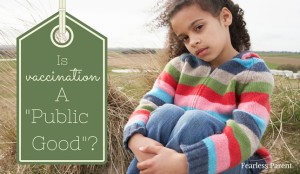I just finished reading a feature article published in The British Medical Journal by BMJ associate editor, Peter Doshi, PhD: “The unofficial vaccine educators: are CDC funded nonprofits sufficiently independent?”
Those who raise concerns about vaccine policy are often asked, “Why aren’t you more balanced?” Perhaps the best response is Doshi’s piece. Is it desirable to seek balance when writing about a topic that is anything but? Faced with the facts, I understand the discomfort.
Vaccination is widely regarded as the greatest medical invention. We are 360° surrounded by vaccine “education.” Children from birth to age 18 receive over 70 doses of 16 vaccines. All of us, from cradle to grave, from newborns, students, and soldiers to pregnant women, healthy adults, health care workers, and the elderly, are exhorted to vaccinate. New programs are constantly being introduced; here’s the latest, the Catch-Up Immunization Scheduler.
The official vaccine educators
The sheer magnitude of resources endorsing, subsidizing, and administering vaccination is extraordinary.
Official vaccine educators include the federal agency, the Centers for Disease Control and Prevention (CDC), and the state health departments plus the pharmaceutical and health insurance industries; hospitals; and virtually all of the 58,726 general pediatricians, 28,374 pediatric specialists, and nearly one million other physicians in the US. And let’s not forget the 312,500 pharmacists, the vast majority of whom were not permitted to vaccinate a mere two decades ago. Did I mention the tens of thousands of school nurses? Oh, and the military.
Tallied up, the multi-billion dollar budgets of these various megalithic entities for promotion and direct-to-consumer advertising keep the vaccine information pipeline full to overflowing. In the US, it means back to school shots. Cocooning to protect newborn baby shots for family and friends. Flu shots during the fall and winter months. Pregnancy shots. Health care worker shots. Tetanus shots for dirty wounds. HPV shots for teens. And so on.
Billions are allocated to vaccine promotion and direct to consumer advertising because vaccines are big business. It’s a $32.5 billion global market (2015), poised to reach $77.5 billion by 2024. Five drug companies control 70% of global vaccine sales revenue: Merck’s $6.25 billion; Sanofi Pasteur’s $5.85 billion; GSK’s $5.26 billion’ Pfizer’s $4.48 billion; and Novartis’ $1.53 billion. Biologics account for over one-third of all of all new drugs in clinical trials or awaiting FDA approval. About $30 billion of NIH funding is vaccine related (see line item funding categories, including vaccine related; immunization; infectious, emerging infectious, rare, vector borne diseases; pneumonia; influenza; HPV, malaria, TB, AIDS vaccines; hepatitis).
I’m leaving out the role of private voluntary organizations and non-governmental organizations in promoting vaccination; most notably, the World Health Organization ($4.4 billion budget) and the Global Alliance for Vaccines and Immunisation ($1.8 billion budget), both of which focus largely (or exclusively) on advancing vaccination worldwide. GAVI is the biggest investment of the Bill and Melinda Gates Foundation, which happens to be the largest charitable foundation in the world.
Taking a closer look at the vaccine nonprofits
Nonprofit organizations are tax-exempt under Internal Revenue Code Section 501(c)(3) as public charities because they are formed to provide public benefit. The IRS reveals that 35.5% are devoted to human services, 13% to health-related causes, and 11.6% to public and societal benefit. Included among their numbers are many vaccine advocacy groups.
Immunization Action Coalition (IAC) is one such nonprofit. It is funded by the CDC, six pharmaceutical corporations (including four of the five industry leaders mentioned above), and various others including federal campaign donors, health plans, hospitals, immunization coalitions, pharmacies, private practices, subscribers, United Way donors, and website contributors.
Here’s IAC’s 2016 IRS Form 990. It spent over $3 million in 2016 including $1+ million on compensation. IAC’s chief strategy officer (LJ Tan) received over $237,000. Charity Navigator gives them a 70 (out of 100) for transparency and accountability.
Reliable and independent info sources?
Doshi asks: “[A]re these groups—which present themselves as reliable sources of information—providing the public with independent information?”
IAC lists over 50 nonprofit organizations as its immunization partners, including:
- 317 Coalition (section 317 funding from Congress for vaccines)
- American Academy of Family Physicians (AAFP)
- American Academy of Pediatrics (AAP)
- American College Health Association (ACHA)
- American College of Nurse-Midwives (ACNM)
- American College of Obstetricians and Gynecologists (ACOG)
- American College of Physicians (ACP)
- American Medical Association (AMA)
- American Nurses Association (ANA)
- American Pharmacists Association (APhA)
- American Travel Health Nurses Association (ATHNA)
- Asian Liver Center at Stanford University (ALC)
- Association of Immunization Managers (AIM)
- Association of State and Territorial Health Officials (ASTHO)
- Association for Prevention Teaching and Research (APTR)
- Association for Professionals in Infection Control and Epidemiology (APIC)
- Autism Science Foundation (ASF)
- Center for Vaccine Awareness and Research (CVAR), Texas Children’s Hospital
- Childhood Influenza Immunization Coalition (CIIC)
- College of Physicians of Philadelphia
- Edward Jenner Vaccine Society
- Every Child By Two (ECBT)
- Families Fighting Flu (FFF)
- Global Polio Eradication Initiative
- Hepatitis B Foundation (HBF)
- Hep B United
- Infectious Diseases Society of America (IDSA)
- Institute for Safe Medication Practices (ISMP)
- International Sharps Injury Prevention Society (ISIPS)
- International Vaccine Access Center (IVAC)
- Institute for Vaccine Safety (IVS)
- Meningitis Angels
- National Adult and Influenza Immunization Summit (NAIIS)
- National Alliance of State and Territorial AIDS Directors (NASTAD)
- National Association for School Nurses (NASN)
- National Association of County & City Health Officials (NACCHO)
- National Cervical Cancer Coalition (NCCC)
- National Foundation for Infectious Diseases (NFID)
- National Medical Association (NMA)
- National Meningitis Association (NMA)
- National Viral Hepatitis Roundtable (NVHR)
- Pediatrics Infectious Diseases Society (PIDS)
- Parents of Kids with Infectious Diseases (PKIDS)
- Sabin Vaccine Institute
- Safe Injection Practices Coalition (SIPC)
- Society for Adolescent Health and Medicine (SAHM)
- Society of Teachers of Family Medicine ( STFM)
- University of Pittsburgh School of Medicine (PittVax)
- Vaccine Education Center (VEC), Children’s Hospital of Philadelphia
- Voices For Vaccines (VFV)
- Women In Government
This partial list of vaccine nonprofits starts to feel more like big ticket primary industry infrastructure with no one happier than the big drug companies whose bottom line these efforts serve.
Laws removing the ability to opt out
Recommending vaccination is one thing. A very big thing, clearly. But still on the side that acknowledges the primacy of informed consent. Informed consent is the acknowledged international human rights standard (see here, article 6).
Informed consent cannot exist without the option to decline.
Two years ago, California became the third state in the country to remove non-medical (i.e., parent-directed) exemptions, following the passage of California Senate Bill 277 (SB277).
Doshi notes that several of the vaccine advocacy groups listed above, including Every Child by Two, the American Academy of Pediatrics, and the IAC, are all nonprofits with large online presences that receive CDC funding and promote themselves as sources of reliable information about vaccines.
CDC asserts that it is neutral on vaccine mandates and does not take positions on state-specific legislation. That is because, as a federal agency, it cannot engage in lobbying. The Constitution granted three types of powers: 1) exclusive federal powers of Congress, 2) concurrent powers shared with the states, and 3) reserved powers (also called states’ rights) that only the states possess. The right to mandate vaccines is a states’ right.
Oh, a tangled (lobbying) web they weave
Doshi asks if ECBT and AAP’s support of SB277 crossed a line. CDC’s top vaccine official sat on ECBT’s board. Did they use non-CDC funds for its lobbying? And how much are ECBT and IAC receiving from vaccine makers? BMJ asked but neither was willing to disclose contribution amounts.
IAC tax filings show $1.3 million from non-governmental sources and funding from Wyeth and Novartis for its VaccinateYourFamily.org and VaccinateYourBaby.org websites. IAC received over $2 million from the CDC since 2009 to help increase vaccine compliance.
Per BMJ, ECBT has received about one-third of its contributions ($220,000 to $275,000 per year) over the past ten years from the CDC, including funding:
- “visits to magazine editors to encourage immunization related stories”
- “monitoring and responding to parent-focused web blogs”
- “hosting information calls for ‘mommy’ bloggers” (remember Megan Media?)
- “exhibiting and providing educational material at a number of professional meetings and conferences.”
Vaccine manufacturers have also funded a coalition that aims to increase Section 317 funding from Congress for infrastructure to implement its vaccination policies. Steering Committee members include Paul Offit, Amy Pisani (ECBT), and LJ Tan (IAC). According to its website, the 317 Coalition engages in “grass roots advocacy” and is “solely focused on advocating for increased [Section] 317 funding.”
Lobbying?
Ever questioned a CDC recommendation?
Asked whether they had ever challenged a CDC vaccine recommendation, the answer was simple.
No.
AAP, ECBT, and IAC all claimed independence. But ECBT also said its official policy is to support official recommendations. AAP’s recommendations have been fully “harmonized” with the CDC’s since 1995.
And they’re not financially, philosophically, or intellectually independent (as observed by journalist Gary Schwitzer of watchdog HealthNewsReviews.org, whose quote closes Doshi’s article with this compelling observation:
My head is spinning listening to this description of the tangled relationships—should we call them co-dependencies?—of these entities. Independence is about being free from outside control or support…
Ensuring such independence seems an essential first step for any organization that wants to seriously respond to public concerns about the safety of childhood vaccines.
The real grassroots vaccine nonprofits
If you’re seeking independent vaccine information from organizations that are not supported by CDC and corporate money, do some due diligence first. Take a peek behind the curtain to see who’s doing the managing, advising, and funding. All nonprofits are required to file an IRS Form 990. You can review details such as executive compensation payments and get a bit of color on the big donors. Websites like Guidestar or Charity Navigator provide objective data on financial health, accountability, and transparency.
More people are asking hard questions and turning to the internet for support. You deserve impartial guidance upon which to base your family’s health care decisions.
Photo credit: Adobe Stock # 64684770












Thank you, Louise!
Thank you! There is so much information here for those of us who share the truth.